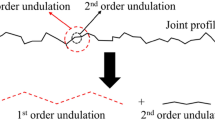Abstract
The mechanical behaviour of structural discontinuities in rock mass is a key element of the stability analysis in civil engineering, petroleum engineering and mining engineering. In this paper, the mechanical analysis is coupled with the acidic attack of a rock joint associated with leakage of CO2 through a geological fault in the context of carbon sequestration. Experiments were conducted at the laboratory scale to assess the shear behaviour of degraded joint: direct shear tests were performed on rock joints that have been previously immersed into water or into an acidic solution (pH 0.2). The shear behaviour of joints is governed by the roughness of its walls: the parameters Z2, Z3, Z4 and RL characterize the rough surfaces. They are calculated from the scans of joint surfaces after and before immersion. Their comparison pointed out a slight impact of the acidic attack. However, the results of the direct shear tests show significant modifications in the shear behaviour for the degraded joints: the tangential stress peak disappears, the tangential stiffness decreases in the stress/displacement curve, and the contraction increases, the dilation angle decreases in the dilation curve. Acid attack has a greater impact on the mechanical properties of the asperities than their geometric characteristics. The results of this study will be used to improve chemo-mechanical modelling to better simulate with higher accuracy the fault stability in different cases of civil engineering, petroleum engineering and mining engineering.
















Similar content being viewed by others
References
ADEME, IFP, BRGM (2005) La capture et le stockage géologique du CO2. Rapport, Réf. 5504, ADEME, Angers, p 44
Andreani M, Gouze P, Luquot L, Jouanna P (2008) Changes in seal capacity of fractured claystone caprocks induced by dissolved and gaseous CO2 seepage. Geophys Res Lett. doi:10.1029/2008GL034467
Barton N (1976) The shear strength of rock and rock joints. Int J Rock Mech Min Sci 13:255–279. doi:10.1016/0148-9062(76)90003-6
Barton N, Lien R, Lunde J (1974) Engineering classification of rock masses for the design of tunnel support. Rock Mech 6:189–236. doi:10.1007/BF01239496
Bemer E, Lombard JM (2009) Fom injectivity to integrity studies of CO2 geological storage: chemical alteration effects on carbonates petro physical and geomechanical properties. Oil Gas Sci Technol Rev Inst Fr Pét 65:445–459
Berry MV, Lewis ZV (1980) On the Weierstrass–Mandelbrot fractal function. Proc R Soc Lond Ser Math Phys Sci 370:459–484. doi:10.2307/2397195
Cappa F, Rutqvist J (2011) Modeling of coupled deformation and permeability evolution during fault reactivation induced by deep underground injection of CO2. Int J Greenh Gas Control 5:336–346. doi:10.1016/j.ijggc.2010.08.005
Egermann P, Bemer E, Zinsziner B (2006) An experimental investigation of the rock properties evolution associated to different levels of CO2 injection like alteration processes. In: SCA2006-34, Trondheim, Norway
Flamant R (2000) Validation d’un modèle de comportement mécanique pour les fractures rocheuses en cisaillement. Ph.D. thesis, Université du Québec à Chicoutimi, Chicoutimi
Gentier S (1986) Morphologie et comportement hydromécanique d’une fracture naturelle dans le granite sous contrainte normale-Étude expérimentale et théorique (Spécialité Mécanique des Roches). Ph.D. thesis, Université d’Orléans, Orléans, France
Jing L (2003) A review of techniques, advances and outstanding issues in numerical modelling for rock mechanics and rock engineering. Int J Rock Mech Min Sci 40:283–353. doi:10.1016/S1365-1609(03)00013-3
Liu L, Suto Y, Bignall G, Yamasaki N, Hashida T (2003) CO2 injection to granite and sandstone in experimental rock/hot water systems. Energy Convers Manage 44:1399–1410
Lopez P (2000) Comportement mécanique d’une fracture en cisaillement: analyse par plan d’expériences des données mécaniques et morphologiques connues sur une fracture. Ph.D. thesis, Université du Québec à Chicoutimi, Canada et Université Bordeaux 1, France
Lopez JM, Schmittbuhl J (1998) Anomalous scaling of fracture surfaces. Phys Rev. doi:10.1103/PhysRevE.57.6405
Marache A (2002) Comportement mécanique d’une fracture rocheuse sous contraintes normale et tangentielle. Université de Bordeaux 1, France
Martin FA, Rivard P (2012) Effects of freezing and thawing cycles on the shear resistance of concrete lift joints. Can J Civ Eng 39:1089–1099. doi:10.1139/L2012-090
Ojala IO (2011) The effect of CO2 on the mechanical properties of reservoir and cap rock. Energy Procedia 4:5392–5397
Riss J, Gentier S, Archambault G, Flamand R (1997) Sheared rock joints: dependence of damage zones on morphological anisotropy. Int J Rock Mech Min Sci. doi:10.1016/S1365-1609(97)00151-2
Rousseau B (2010) Interfaces fragiles des ouvrages hydrauliques: morphologie et comportement mécanique. Ph.D. thesis, Université de Bordeaux 1 et Université de Sherbrooke, Sherbrooke, Canada
Rousseau B, Rivard P, Marache A, Ballivy G, Riss J (2012) Limitations of laser profilometer limitations in measuring surface topography for polycrystalline rocks. Int J Rock Mech Min Sci 52:56–60
Soltanzadeh H, Hawkes CD (2009) Assessing fault reactivation tendency within and surrounding porous reservoirs during fluid production or injection. Int J Rock Mech Min Sci 5:1–7. doi:10.1016/j.ijrmms.2008.03.008
Tonnet N, Broseta D, Mouronval G (2010) Evaluation of the petro physical properties of a carbonate-rich caprock for CO2 geological storage purposes. Society of Petroleum Engineers. doi:10.2118/131525-MS
Tse R, Cruden DM (1979) Estimating joint roughness coefficients. Int J Rock Mech Min Sci 16:303–307. doi:10.1016/0148-9062(79)90241-9
Vasarhelyi B (1999) Shear failure in rock using different constant normal load. Period Polytech Ser Civ Eng 43:179–186
Yang ZY, Lo SC, Di CC (2001) Reassessing the joint roughness coefficient (JRC) estimation using Z2. Rock Mech Rock Eng 34:243–251
Acknowledgements
The authors are grateful to the rock mechanic laboratory of the University of Sherbrooke where experiments were performed, grateful to the Natural Sciences and Engineering Research Council of Canada (NSERC) for funding the project, and grateful to George Lalonde, technician, for his help to mount the set-up.
Author information
Authors and Affiliations
Corresponding author
Rights and permissions
About this article
Cite this article
Nouailletas, O., Perlot, C., Rivard, P. et al. Impact of Acid Attack on the Shear Behaviour of a Carbonate Rock Joint. Rock Mech Rock Eng 50, 1439–1451 (2017). https://doi.org/10.1007/s00603-017-1182-6
Received:
Accepted:
Published:
Issue Date:
DOI: https://doi.org/10.1007/s00603-017-1182-6




